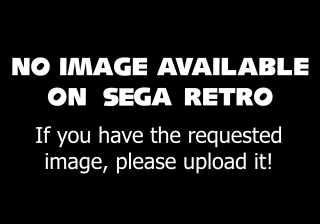Sega CS1
From Sega Retro

| ||
| Sega CS1 Division of Sega Enterprises | ||
|---|---|---|
| Founded: 1991 | ||
| Defunct: 1995 | ||
Headquarters:
| ||
1991 1995
Sega CS →
|
Sega Consumer Research and Development Dept. #1 (nickamed Sega CS1, which it was officially renamed to in 1994)[1] was a video game research and development division within Sega. As the name suggests, it was the first "consumer"-specific R&D department created by Sega of Japan, focusing on Mega Drive and Mega-CD software. It is unknown exactly when it was founded, but was done so in 1990 or 1991, likely alongside the establishment of several AM and other CS divisions. Several notable developers got their start at CS1, such as Takao Miyoshi, Takashi Iizuka, Takaya Segawa, Kouichi Toya, Kazuyuki Hoshino, Yuji Uekawa and Yumiko Miyabe. The department was located in the PK Building.[2]
The department was disbanded in 1995 and reformed in 1996, with different developers going primarily to Sega CS1 and Sega CS3.
Contents
History
Consumer Research and Development Dept. #1 was established as the successor to Research & Development Dept. 9. It continued some of its previous exploits, whether it was developing games for Sega Game Toshokan (mostly developed by newcomers) or original games for the Sega Mega Drive.
CS1 produced a variety of diverse games, several with outside developers such as Shigeharu Isoda and others for Tougi Ou King Colossus and Bio-Hazard Battle, Minato Giken for Columns III: Revenge of Columns and Compile for Dr. Robotnik's Mean Bean Machine. The department's biggest project was Phantasy Star IV: The End of the Millennium, which had a lengthy development period that completely occupied several staff members' focus.[2]
With the approach of the Sega Saturn, CS1 and CS2 were assigned to develop software for the new hardware. Early releases mainly relied on co-development with System Sacom, with its internal talent later spawning some of the more populated Saturn-specific franchises, Panzer Dragoon, Victory Goal, Greatest Nine and Clockwork Knight.
It was abolished in 1995 alongside every other separate consumer department and merged into a temporary single department, with a new Sega CS1 established in 1996.[3] Some notable CS1 developers, however, such as Yuji Naka and Naoto Ohshima, were part of the new Sega CS3.
Management
Its known managers are Makoto Oshitani in 1991,[4][5] Minoru Kanari in 1992, with section managers Junichi Tsuchiya (design), Hiroyasu Lee (programming) and Yukio Sato (art),[6] and then Yoji Ishii in 1993 and 1994[6], first with section managers Yukio Sato (art, section 1), Shuichi Katagi (unspecified role. programming, section 1?), Noriyoshi Ohba (design, section 1), Hirotsugu Kobayashi (design, section 1), Masayuki Hasegawa (art, section 2) and Takashi Shoji (programming, section 2),[6], before the section manager system was abolished in 1993 in favour of just producers, with Shuichi Katagi also present as technical chief.[1]
Softography
Mega Drive
- 16t (1991)
- Aworg: Hero in the Sky (1991)
- Golden Axe II (1991)
- Medal City (1991)
- Pyramid Magic III (1991)
- Robot Battler (1991)
- Sonic Eraser (1991)
- Pyramid Magic II (1991)
- Phantasy Star II: Rudger's Adventure (1991)
- Pyramid Magic Editor (1991)
- Phantasy Star II: Nei's Adventure (1991)
- Riddle Wired (1991)
- Mercs (1991)
- Kiss Shot (1992)
- Tougi Ou King Colossus (1992)
- Honoo no Toukyuuji Dodge Danpei (1992)
- Bio-Hazard Battle (1992)
- J.League Pro Striker (1993)
- Golden Axe III (1993)
- Columns III: Revenge of Columns (1993)
- Party Quiz Mega Q (1993)
- Dr. Robotnik's Mean Bean Machine (1993)
- J.League Pro Striker Kanzenban (1993)
- Phantasy Star IV: The End of the Millennium (1993)
- Streets of Rage 3 (1994) (art)
- Ristar (1995) (early development)
- RPG Densetsu Hepoi (unreleased)
Mega-CD
- Quiz Scramble Special (1992)
- Sonic the Hedgehog CD (1993) (early development?)
Saturn
- Gale Racer (1994)
- The Mansion of Hidden Souls (1994)
- Clockwork Knight (1994)
- Victory Goal (1995)
- Cyber Speedway (1995)
- Kanzen Chuukei Pro Yakyuu Greatest Nine (1995)
- SimCity 2000 (1995)
- Fighting Circus: Elandoll (unreleased)
List of staff
- Cotani
- Yoshiaki Endo
- Yukio Futatsugi
- Masayuki Hasegawa
- Takashi Iizuka
- Kazuo Ikeda
- Manabu Ishihara
- Yoji Ishii
- Tomoyuki Ito
- Kazuyuki Iwasawa
- Minoru Kanari
- Shuichi Katagi
- Shiro Kinemura
- Hirotsugu Kobayashi
- Tomohiro Kondo
- Makiko Kubo
- Manabu Kusunoki
- Ryuichiro Kutsuzawa
- Hiroyasu Lee
- Shiro Maekawa
- Marsh
- Minoru Matsuura
- Yumiko Miyabe
- Tsukasa Mori
- Miki Morimoto
- Hideaki Moriya
- Mayumi Moro
- Kazuyuki Mukaida
- Toshiyuki Mukaiyama
- Yuji Naka
- Atsuhiko Nakamura
- Takeshi Niimura
- Yojiro Ogawa
- Noriyoshi Ohba
- Naoto Ohshima
- Shigeru Okada
- Toshiko Okano
- Yosuke Okunari
- Makoto Oshitani
- Hiroto Saeki
- Katsuhiko Sato
- Katsuhisa Sato
- Yukio Sato
- Takaya Segawa
- Takashi Shoji
- Junichi Suto
- Makiko Suzuki
- Hidetoshi Takeshita
- Kou Tanaka
- Takaharu Terada
- Yoshitaka Tezuka
- Atsushi Tomari
- Kouichi Toya
- Junichi Tsuchiya
- Yuji Uekawa
- Usagi
- Katsuhiko Yamada
- Daisuke Yamamoto
- Masanobu Yamamoto
- Tomohiro Yamamoto
- Takayuki Yanagihori
- Kentaro Yoshida
- Toru Yoshida
- Takashi Yuda
References
- ↑ 1.0 1.1 Harmony, "1994 5-6" (JP; 1994-05-23), page 15
- ↑ 2.0 2.1 https://tzk-gamedesign.hatenablog.jp/entry/2023/04/23/012721 (Wayback Machine: 2023-08-23 16:00)
- ↑ Sega Saturn Magazine, "1996-09 (1996-06-14)" (JP; 1996-05-24), page 138
- ↑ Mega Drive Fan, "September 1991" (JP; 1991-08-xx), page 106
- ↑ Mega Drive Fan, "January 1992" (JP; 1991-12-07), page 92
- ↑ 6.0 6.1 6.2 Harmony, "1993 5-6" (JP; 1993-05-20), page 15
| Timeline of Sega of Japan research and development divisions |
|---|
|
83
84
85
86
87
88
89
90
91
92
93
94
95
96
97
98
99
00
01
02
03
04
05
06
07
08
09
10
11
12
13
14
15
16
17
18
19
20
21
22
|